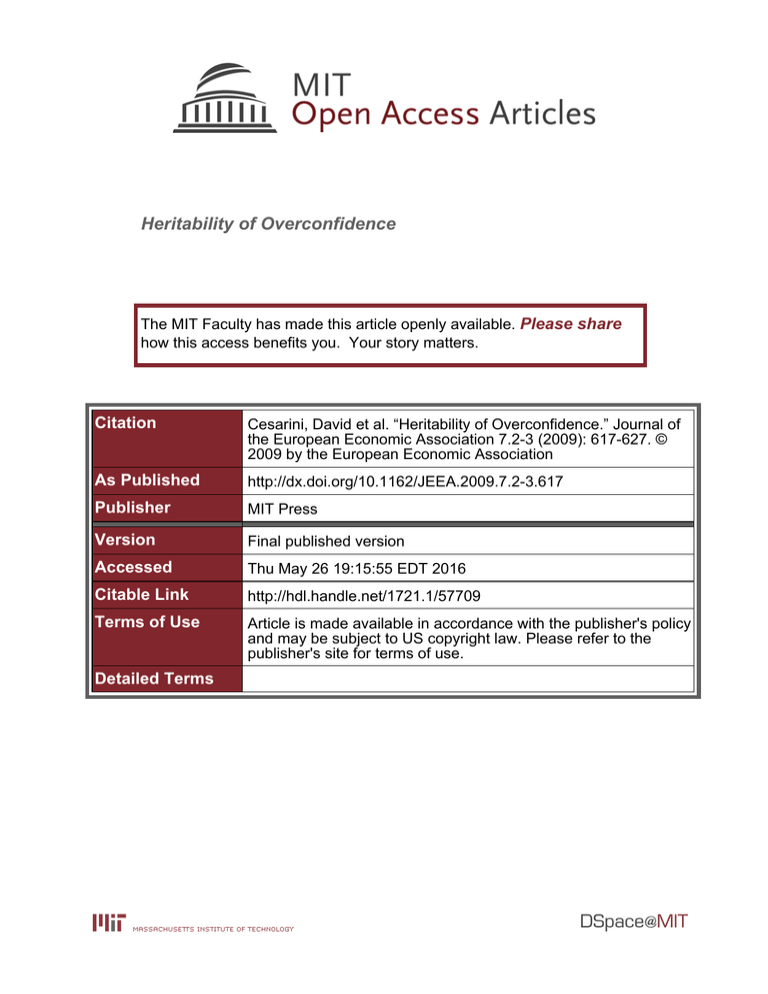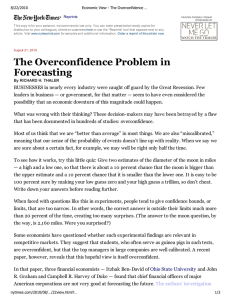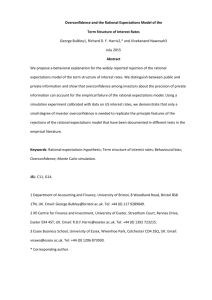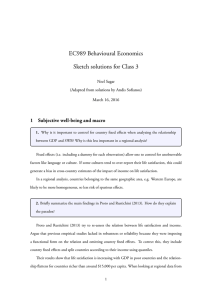Heritability of Overconfidence Please share
advertisement

Heritability of Overconfidence The MIT Faculty has made this article openly available. Please share how this access benefits you. Your story matters. Citation Cesarini, David et al. “Heritability of Overconfidence.” Journal of the European Economic Association 7.2-3 (2009): 617-627. © 2009 by the European Economic Association As Published http://dx.doi.org/10.1162/JEEA.2009.7.2-3.617 Publisher MIT Press Version Final published version Accessed Thu May 26 19:15:55 EDT 2016 Citable Link http://hdl.handle.net/1721.1/57709 Terms of Use Article is made available in accordance with the publisher's policy and may be subject to US copyright law. Please refer to the publisher's site for terms of use. Detailed Terms HERITABILITY OF OVERCONFIDENCE David Cesarini Magnus Johannesson Massachusetts Institute of Technology Stockholm School of Economics Paul Lichtenstein Björn Wallace Karolinska Institutet Stockholm School of Economics Abstract Empirical evidence suggests that people on average overestimate their own ability in a variety of circumstances. Little is known, however, about the origins of such overconfidence. To shed some light on this issue, we use the classic twin design to estimate the genetic and environmental contributions to individual differences in overconfidence. We collect data on overconfidence among 460 twin pairs. Overconfidence is measured as the difference between the perceived and actual rank in cognitive ability. Cognitive ability is measured using a 20-minute test of general intelligence. We find a highly significant joint effect of genes and common environment, but our estimates of the relative contributions of genetic and common environmental variation are less precise. According to our point estimates, genetic differences explain 16–34% of the variation in overconfidence depending on the definition of overconfidence used and common environmental differences explain 5–11%. (JEL: C91, D87, Z13) 1. Introduction Following the seminal contribution of Svenson (1981), who reported an aboveaverage effect in perceived driving ability, a number of psychological studies have found evidence of overconfidence in various domains. Recently, economists have analyzed how this finding might be brought to bear on a number of important issues in economics, for instance excess entry into markets (Camerer and Lovallo 1999), and gender differences in competitiveness (Niederle and Vesterlund 2007). However, little is known about individual variation in overconfidence. One way to examine individual variation is to ask to what extent individual differences are genetically inherited or shaped by environmental differences. Acknowledgments: We thank an anonymous referee for helpful comments and the Jan Wallander and Tom Hedelius Foundation, the Swedish Research Council, and the Swedish Council for Working Life and Social Research for financial support. The Swedish Twin Registry is supported by grants from the Swedish Research Council, The Ministry for Higher Education, and AstraZeneca. E-mail addresses: Cesarini: cesarini@MIT.EDU; Johannesson: magnus.johannesson@hhs.se; Lichtenstein: paul.lichtenstein@ki.se; Wallace: bjorn.wallace@hhs.se Journal of the European Economic Association April–May 2009 © 2009 by the European Economic Association 7(2–3):617–627 618 Journal of the European Economic Association In this study we use the classic twin design to investigate this issue. The virtue of the twin design is that by comparing monozygotic twins, who share the same set of genes, and dizygotic twins, whose genes are imperfectly correlated, we can estimate the proportion of variance in phenotype due to genetic, shared, and non-shared environmental effects (Neale and Cardon 1992). We collect data on overconfidence among 460 twin pairs. From the same data collection we have previously reported results showing that genetic differences explain a sizeable fraction of the variation in economic preferences (Wallace et al. 2007; Cesarini et al. 2008; Cesarini et al. 2009). Overconfidence is measured as the difference between the perceived and actual rank in cognitive ability. In a second adjusted overconfidence measure we also control for the effect of cognitive ability on overconfidence in this measure. Actual cognitive ability is measured using a 20-minute test of cognitive ability, whereas perceived cognitive ability is measured by asking participants to indicate how they believe they will rank, prior to taking the test. We find a highly significant joint effect of genetic and common environmental variation. Our point estimates are less precise, but suggest that genetic variation is more important than common environmental variation. According to our point estimates genetic differences explain 16–34% of the variation in overconfidence depending on the definition of overconfidence used, and common environmental differences explain 5–11%. 2. Design and Methods The study was undertaken in collaboration with the Swedish Twin Registry (Lichtenstein et al. 2006) at Karolinska Institutet and data was collected in 16 major Swedish cities in summer 2006 and spring 2008. We invited same-sex twins born between 1960 and 1985 living in these cities to participate in the study. A condition for participation was that both twins in a pair were able to attend the same experimental session. The invitations were sent out by e-mail and were only sent out to twin pairs that had previously participated in a Web-based survey called STAGE (The Study of Twin Adults: Genes and Environment). The STAGE survey was administered to all twins in Sweden born 1960–1985, and achieved a response rate of 61%. In total 460 twin pairs participated in our study: 319 monozygotic (MZ) twin pairs and 141 dizygotic (DZ) twin pairs. Out of the 920 participants, 16 subjects failed to respond to the overconfidence question or to complete the test of cognitive ability. Thus, our data set in the analysis consists of 904 individual observations (629 MZ twins and 275 DZ twins), and 444 complete twin pairs (311 MZ pairs and 136 DZ pairs). Zygosity was assigned by questionnaire items which have been shown to have a reliability of 95–98% (Lichtenstein et al. 2006). See Cesarini et al. (2009) for a further discussion about the representativeness of our sample and for full details on experimental procedures. Cesarini et al. Heritability of Overconfidence 619 To measure overconfidence, subjects filled out a short questionnaire and then took a test of cognitive ability. In the last question on the questionnaire subjects were informed that they were about to take a test of cognitive ability, and were asked to estimate how they would rank relative to other participants in the study. Subjects rated which decile in the distribution of cognitive ability they thought they belonged to. Overconfidence can then be measured as the difference between the actual ranking on the cognitive test and the perceived ranking in the overconfidence question (with both rankings standardized between 1–100). The cognitive ability test used is a short, standard psychometric test of general intelligence developed by the Swedish psychometric company Psykologiförlaget (Sjöberg, Sjöberg, and Forssén 2006). Subjects had 20 minutes to complete the test, and were notified with 5 and 1 minutes remaining. The test is divided into three sections on analogies, number series, and logical series. We refer to the test score as cognitive ability. We report results for overconfidence defined in two different ways with our data. First we report results for an unadjusted measure of overconfidence as defined previously. We refer to this measure as “unadjusted overconfidence.” A potential problem with this measure of overconfidence is that there may be floor and ceiling effects; a person with an actual cognitive ability in the first decile cannot be overconfident by definition (and a person in the lowest decile can conversely not be “underconfident”). This problem, discussed at length in Juslin, Winman, and Olsson (2000) and Erev, Wallsten, and Budescu (1994), may create an artificial correlation between overconfidence and cognitive ability. As cognitive ability is heritable (Plomin and Rende 1991), such an artificial correlation will lead to upward bias in the estimated heritability in overconfidence. We therefore also construct a second overconfidence measure controlling for the actual ranking in cognitive ability. To construct this measure of overconfidence we residualize unadjusted overconfidence on cognitive ability. The residuals of this regression are used as our second measure of overconfidence. We refer to this second overconfidence measure as “adjusted overconfidence” herein. As it is possible that overconfidence varies with cognitive ability so that individuals with higher cognitive ability are less overconfident, it is likely that this measure underestimates the heritability of overconfidence. If so, we can therefore interpret our two measures of overconfidence as providing an upper and a lower bound on heritability. Twin methodology utilizes the difference in genetic relatedness between MZ and DZ twins to identify the heritability of a trait. MZ twins have identical genes and DZ twins share 50% of the same genes on average. This implies that the correlation in a trait will be higher for MZ twins than DZ twins if the trait is heritable. As a first test of heritability in overconfidence we therefore compare the correlations in overconfidence between MZ and DZ twin pairs. We use bootstrap techniques to test if the MZ correlation exceeds the DZ correlation, that 620 Journal of the European Economic Association is, testing the hypothesis that genetics exerts an influence on overconfidence.1 The MZ correlations also provide an estimate of the fraction of the variance in overconfidence that is jointly explained by genes and common environment. We therefore test if the MZ correlation differs from zero to provide a test of this joint hypothesis. In addition we provide a full-fledged variance decomposition by estimating an ACE model (Neale and Cardon 1992). This workhorse model in the behavior genetics literature posits that additive genetic factors (A), common environmental factors (C), and specific environmental factors (E) account for all individual differences in the phenotype of interest. Common environment factors are typically thought of as those environmental influences shared by both twins, for instance the home environment they are raised in. Specific environmental effects include environmental factors not shared by the other twin. Any measurement error will also show up in the specific environmental influences. Start with the case of MZ twins. Let all variables, including the phenotype, be expressed as deviations from zero and standardize them to have unit variance. Consider a pair of MZ twins and suppose first that the phenotype can be written as the sum of two independent influences: additive genetic effects, A, and environmental influences, U . We then have that P = aA + uU, and, using a superscript to denote the variables for twin 2 in a pair, P = aA + uU . Because for MZ twins A = A , the covariance (which, due to our normalization, is also a correlation) between the phenotypes of the two twins is given by ρMZ = a 2 + u2 Cov(U, U )MZ . Now consider a DZ pair. Under the assumptions of random-assortative mating with respect to the trait of interest, and genetic additivity, it will be the case that Cov(A, A )DZ = 0.5. We then have that ρDZ = a 2 + u2 Cov(U, U )DZ . 1. Letting NMZ be the number of MZ pairs, we draw NMZ pairs with replacement 1,000 times and calculate both the parametric and the non-parametric correlation each time. We do the same for DZ twins, and then create a 1,000 × 1 vector where the DZ correlation is subtracted from the MZ correlation for each draw. This gives a distribution for the difference in correlation between the two samples. The one-sided p-value for the test of the hypothesis that the two correlations are equal is then equal to the number of instances where the vector of differences takes a negative value divided by ten. Cesarini et al. Heritability of Overconfidence 621 Finally, we impose the equal environment assumption, namely, that Cov(U, U )MZ = Cov(U, U )DZ . Critics of the classic twin design cite a number of alleged failures of the equal environment assumption. A common theme of these criticisms is that MZ twins receive more similar treatment (Pam et al. 1996). It is important to emphasize that even if MZ twins are treated more similarly, this does not in and of itself constitute a violation of the assumption; greater similarity in environment may be caused by the greater similarity in genotypes (Plomin et al. 2001). Such similarity may arise for two reasons: Genes may affect the way in which environment reacts to an individual, and genes can affect the environment individuals choose for themselves (Jencks 1980). The most important evidence in favor of the equal environment assumption is that studies of MZ and DZ twins who were reared apart tend to produce estimates of heritability similar to those using twins reared together (Bouchard 1998). Because studies of twins reared apart do not rely on the equal environments assumption, findings from such studies seem to validate the basic model. Also, in the relatively rare cases where parents miscategorize their twins as MZ instead of DZ (or the converse), differences in correlations of cognitive ability and personality persist (Bouchard and McGue 2003). It follows from these assumptions that heritability, the fraction of variance explained by genetic factors, is identified as a 2 = 2(ρMZ − ρDZ ). In the standard behavior genetics framework, environmental influences are generally written as the sum of a common environmental component and a non-shared environmental component such that P = aA + cC + eE. With this terminology, the environmental covariance component of the phenotypic correlation, u2 Cov(U, U ), can be written as c2 , because by definition any covariance must derive only from the common component. This allows us to write the individual variation as the sum of three components a 2 , c2 , and e2 ; a 2 is the share of variance explained by genetic differences, c2 is the share of variance explained by common environmental influences, and e2 the share of variance explained by non-shared environmental influences. There are a number of ways in which the parameters of this model can be estimated. We follow standard practice in using maximum likelihood under the assumption that the phenotype comes from a bivariate normal distribution. In particular, following directly from our derivation, the likelihood is maximized under the restriction that the variance-covariance matrix is of the form a 2 + c2 + e2 , Ri a 2 + c2 , = Ri a 2 + c2 , a 2 + c2 + e2 622 Journal of the European Economic Association where Ri takes the value 1 if the observation is of an MZ pair, and 0.5 otherwise. The analyses are run in MPLUS (Muthén and Muthén 2006), a numerical optimizer often used in behavior genetics. We estimate three models in addition to the ACE model. These three are an AE model restricting the effect of common environment to zero; a CE model restricting the genetic effect to zero; and an E model that restricts both the genetic and the common environment effects to zero. 3. Results To validate the survey question on perceived cognitive ability we tested if the perceived rank was correlated with the actual rank. The Spearman correlation is 0.25 and this correlation is highly significant (p < 0.01). The distribution of overconfidence for MZ and DZ twins are shown in Figure 1. As can be seen the distributions are similar, and we cannot reject the null hypothesis of no difference (Kolmogorov–Smirnov test; p-value = 0.75). On average subjects are mildly overconfident. The overconfidence is 5.95 for MZ twins and 6.02 for DZ twins. Both differences are significantly different from 0 (p < 0.01). The average individual in the study thus overestimates the actual ranking in cognitive ability by about 6 on the standardized 1–100 ranking. Figure 2 shows a scatterplot of unadjusted overconfidence between the two twins in MZ and DZ pairs. The overconfidence is clearly correlated between twins Figure 1. The distribution of unadjusted overconfidence for monozygotic (MZ) and dizygotic (DZ) twins. Cesarini et al. Heritability of Overconfidence 623 Figure 2. Scatterplot of unadjusted overconfidence for monozygotic (MZ) and dizygotic (DZ) twin pairs. among MZ pairs. Also for DZ pairs we can see a positive correlation in the figure. The correlation coefficients are shown in Table 1. The Spearman correlation is 0.44 for MZ twins. The point estimate suggests that genetic and common environmental effects explain 44% of the variance in overconfidence; this effect is highly significant. The DZ correlation is 0.29. The lower correlation for DZ pairs is consistent with a genetic effect in overconfidence. However, the difference in correlation coefficients between MZ and DZ pairs is only marginally significant (p-value = 0.06). When we use the adjusted overconfidence measure as our outcome variable, the correlations are, as expected, lower (as shown in Figure 3 and Table 1). The correlation is 0.29 for MZ twins and this joint effect of genes and common environment is still highly significant. The DZ correlation is 0.18. The lower correlation for DZ pairs is consistent with a genetic effect in overconfidence, Table 1. Correlations for monozygotic and dizygotic twin pairs (95% confidence intervals within parentheses). Unadjusted Pearson overconfidence Spearman # pairs Adjusted Pearson overconfidence Spearman # pairs Monozygotic twin pairs Dizygotic twin pairs p-value of diff. 0.440 (0.331–0.530) 0.436 (0.340–0.534) 311 0.295 (0.112–0.436) 0.286 (0.126–0.444) 136 0.06 0.211 (0.114–0.344) 0.235 (0.119–0.351) 311 0.138 (−0.037 to 0.347) 0.177 (0.008–0.347) 136 0.22 0.06 0.27 624 Journal of the European Economic Association Figure 3. Scatterplot of adjusted overconfidence for monozygotic (MZ) and dizygotic (DZ) twin pairs. but the difference in correlation coefficients between MZ and DZ pairs is not statistically significant with this more conservative measure of overconfidence (p-value = 0.27). We then turn to the variance decomposition results in the ACE model. These results are shown in Table 2. We report results both for the most general ACE model and its various nested submodels. Bootstrapped 95% confidence intervals for all parameters are also reported in parentheses. Heritability is 0.34 for the Table 2. Maximum likelihood estimates of the structural equation ACE model and its submodels (95% confidence intervals in parentheses). Unadjusted overconfidence A C E ln∗ (L) ACE AE CE E 0.338 (0.000–0.521) 0.109 (0.000–0.407) 0.554 (0.463–0.652) −4278.429 0.454 (0.362–0.540) − − − 0.391 (0.303–0.468) 0.609 (0.530–0.697) −4280.594 − 0.546 (0.458–0.637) −4278.669 1.000 (1.000–1.000) −4317.754 Adjusted overconfidence A C E ln∗ (L) 0.161 (0.000–0.323) 0.053 (0.000–0.235) 0.785 (0.658–0.911) −3862.607 0.220 (0.089–0.350) − 0.780 (0.648–0.905) −3862.658 − − 0.187 (0.084–0.291) 0.813 (0.707–0.916) −3862.966 − 1.000 (1.000–1.000) −3870.920 Cesarini et al. Heritability of Overconfidence 625 unadjusted overconfidence, and 0.16 for adjusted overconfidence. Common environment is estimated at 0.11 and 0.05, respectively. With bootstrapped confidence intervals, the estimated coefficients are not significant at the 5% level. We also report estimates from the nested submodels, which effectively restrict one of the variance components to equal zero. A simple likelihood ratio test, exploiting the fact that twice the difference in likelihood has an asymptotic χ 2 distribution, can be used to test if such a restriction entails a significant deterioration in fit (Neale and Miller 1997). Comparing the ACE model to an E model, the deterioration in fit is highly significant for both unadjusted (χ 2 = 78.65, p < 0.01) and adjusted overconfidence (χ 2 = 16.62, p < 0.01). Comparing the ACE model to a CE model for unadjusted overconfidence, the difference is significant at the 5% level (χ 2 = 4.33, p < 0.05). For adjusted overconfidence the difference between the ACE and the CE model is not significant (χ 2 = 0.72, p = 0.40). 4. Concluding Remarks We find a highly significant joint effect of genes and common environment for both measures of overconfidence. According to the point estimates for unadjusted (adjusted) overconfidence, genetic differences explain 34% (16%) of the variation in overconfidence and common environmental differences explain 11% (5%). What are the implications of these findings? A number of authors have pointed out that there is a sense in which heritability estimates are structurally uninformative (Goldberger 1979; Jencks 1980). Unless we know why a trait is heritable, a heritability estimate per se says little about the malleability of the trait with respect to environmental interventions (Goldberger 1979; Jencks 1980). There are at least two substantive implications of the results reported here. The first is the perhaps most important lesson from behavior genetics: nonzero heritabilities have methodological consequences. Specifically, a definitive finding of genetic variance in overconfidence would mean that correlations in overconfidence between relatives cannot be given an environmental interpretation. Second, the findings reported here are broadly consistent with studies in behavior genetics, which typically report moderate to large genetic effects, and small to moderate effects of family environment, on a wide range of social attitude variables like personality and political preferences (Bouchard et al. 1990; Bouchard and McGue 2003; Rushton 2004; Alford, Funk, and Hibbing 2005). The fact that similar patterns have recently been reported in economic preferences (Wallace et al. 2007; Cesarini et al. 2008; Cesarini et al. 2009) adds to the mounting evidence that many of the lessons that have been drawn from the study of psychological traits also carry over to economic “phenotypes.” Researchers in the differential psychology tradition routinely point out that merely averaging across groups can mask important individual differences and 626 Journal of the European Economic Association it is well known that under some conditions, such individual biases might matter also for aggregate outcomes (Fehr and Tyran 2005). There are a number of instances in which one might expect individual differences, regardless of their origin, to be important for economics. For example, it is widely believed that workers self-select into occupations that reflect their comparative advantages. The findings reported here suggest that it would probably be a mistake to think of these comparative advantages as merely environmentally determined and that a more inclusive approach is called for, one which also treats genetic predispositions as sources of comparative advantage. More generally, the results reported here coupled with previous related work unequivocally point to genes as an important source of individual variation in economic preferences as well as behavioral biases. References Alford, John R., Carolyn L. Funk, and John R. Hibbing (2005). “Are Political Orientations Genetically Transmitted?” American Political Science Review, 99, 153–167. Bouchard, Thomas J. Jr., David T. Lykken, Matt McGue, Nancy L. Segal, and Auke Tellegen (1990). “Sources of Human Psychological Differences: The Minnesota Study of Twins Reared Apart.” Science, 250, 223–226. Bouchard, Thomas J. Jr. (1998). “Genetic and Environmental Influences on Adult Intelligence and Special Mental Abilities.” Human Biology, 70, 257–279. Bouchard, Thomas J. Jr., and Matt McGue (2003). “Genetic and Environmental Influences on Human Psychological Differences.” Journal of Neurobiology, 54, 4–45. Camerer, Colin, and Dan Lovallo (1999). “Overconfidence and Excess Entry: An Experimental Approach.” American Economic Review, 89, 306–318. Cesarini, David, Christoper T. Dawes, James H. Fowler, Magnus Johannesson, Paul Lichtenstein, and Björn Wallace (2008). “Heritability of Cooperative Behavior in the Trust Game.” Proceedings of the National Academy of Sciences, 105, 3721–3726. Cesarini, David, Christopher T. Dawes, Magnus Johannesson, Paul Lichtenstein, and Björn Wallace (2009). “Genetic Variation in Preferences for Giving and Risk-Taking.” Quarterly Journal of Economics. Erev, Ido, Thomas S. Wallsten, and David V. Budescu (1994). “Simultaneous Over- and Underconfidence: The Role of Error in Judgment Processes.” Psychological Review, 101, 519–527. Fehr, Ernst, and Jean-Robert Tyran (2005). “Individual Irrationality and Aggregate Outcomes.” Journal of Economic Perspectives, 19, 43–66. Goldberger, Arthur S. (1979). “Heritability.” Economica, 46, 327–347. Jencks, Christopher (1980). “Heredity, Environment, and Public Policy Reconsidered.” American Sociological Review, 45, 723–736. Juslin, Peter, Anders Winman, and Henrik Olsson (2000). “Naïve Empiricism and Dogmatism in Confidence Research: A Critical Examination of the Hard-Easy Effect.” Psychological Review, 107, 384–396. Lichtenstein, Paul, Patrick F. Sullivan, Sven Cnattingius, Margaret Gatz, Sofie Johansson, Eva Carlström, Camilla Björk, Magnus Svartengren, Alicja Wolk, Lars Klareskog, Ulf de Faire, Martin Schalling, Juni Palmgren, and Nancy L. Pedersen (2006). “The Swedish Twin Registry in the Third Millennium: An Update.” Twin Research and Human Genetics, 9, 875–882. Cesarini et al. Heritability of Overconfidence 627 Muthén, Linda K., and Bengt O. Muthén (2006). Mplus. Statistical Analysis with Latent Variables. User’s Guide, version 4.1. Los Angeles, California. Neale, Michael C., and Lon R. Cardon (1992). Methodology for Genetic Studies of Twins and Families. Kluwer Academic Publishers. Neale Michael C., and Michael B. Miller (1997). “The Use of Likelihood-Based Confidence Intervals in Genetic Models.” Behavior Genetics, 27, 113–120. Niederle, Muriel, and Lise Vesterlund (2007). “Do Women Shy Away From Competition? Do Men Compete Too Much?” Quarterly Journal of Economics, 122, 1067–1101. Pam, Alvin, Susan S. Kemker, Colin A. Ross, and R. Golden (1996). “The Equal Environments Assumption in MZ-DZ Twin Comparisons: An Untenable Premise of Psychiatric Genetics?” Acta Geneteticae Medicae Gemellologiae (Roma), 45, 349–360. Plomin, Robert, and Richard Rende (1991). “Human Behavioral Genetics.” Annual Review of Psychology, 42, 161–190. Plomin, Robert D., John C. DeFries, Gerald E. McClearn, and Peter McGuffin (2001). Behavioral Genetics, 4th ed. Freeman (New York, NY). Rushton, J. Philippe (2004). “Genetic and Environmental Contributions to Pro-Social Attitudes: A Twin Study of Social Responsibility.” Proceedings of the Royal Society B, 271, 2583– 2585. Sjöberg, Anders, Sofia Sjöberg, and Katarina Forssén (2006). Predicting Job Performance, PJP. Manual. Assessio AB (Stockholm). Svenson, Ola (1981). “Are We All Less Risky and More Skillful Than Our Fellow Drivers?” Acta Psychologica, 47, 143–148. Wallace, Björn, David Cesarini, Paul Lichtenstein, and Magnus Johannesson (2007). “Heritability of Ultimatum Game Responder Behavior.” Proceedings of the National Academy of Sciences, 104, 15631–15634.








